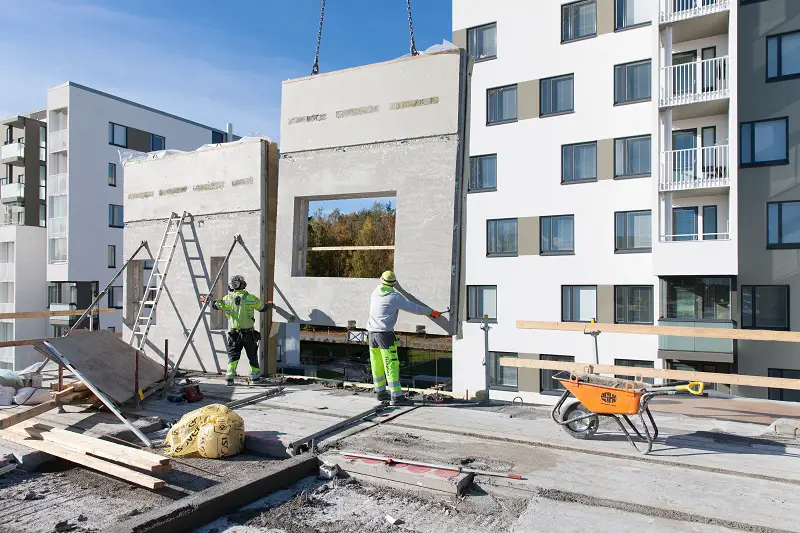Rapid population growth is leading to a major demand for new infrastructure in many large cities in Africa, South America, and India, which all have a housing shortage of tens of millions of apartments. People need safer and more comfortable places to live, and prices need to be reasonable. Precast construction is a cost-efficient, fast and sustainable building technology for large housing projects that doesn’t compromise on quality.
In rapidly urbanizing areas, land has become a scarce commodity. Many governments aim to improve the situation by investing in infrastructure renewal. “In Kenya, for example, the government is committed to ensuring every citizen has access to affordable housing. Investing in precast technology means long-lasting, secure and comfortable homes for those in need,” says Ismo Kallio, Vice President, Salesat Elematic.
A modular and efficient building system
Precast is a modular building system based on ready-made, factory-manufactured components and intelligent connections.It provides a way to design and construct a sufficient number of suitable homes to meet the needs of city dwellers in a reasonable time-frame and at a reasonable cost.
“It is a smart and industrialized way to construct cost-efficient buildings,” says Prakash Shah, Head of Technical Support at Elematic.The competitive and proven precast solutions result in controlled quality, along with a long service life and low maintenance costs, and flexibility in design.
Compared to traditional cast-in-situ, precast uses less cement, water, steel, and labor.Most of the work is transferred from the site to a safe and controlled, automated factory environment. This results in improved productivity and minimal logistics: precast products can be transported to a site ready-to-install.
Any type of element with just one investment
Modern precast concrete production plants are scaled to meet the need: the deliveries always take possible future capacity expansion into account. The same production line allows the manufacture of precast products from affordable to high-end housing, as well as for factories and office complexes.
“The production lines are very versatile with a nearly unlimited palette of options – just change the type of the element, or the surface material. You can start with elements for more affordable buildings, for example, and later change to another product type for the project at hand or market needs,” says Kallio.
Savings in concrete and energy
Precast buildings are well-suited to hot climates. Both the thermal and sound insulation properties of precast are very advanced. Precast concrete buildings absorb and store surplus heat and slowly release it back into the air.
Precast can also be used for buildings in seismic areas, when the specific local requirements are taken into account in analysis and design. Demands for precast connection types vary among different precast products, local building conditions, occupancy requirements, and loads. A building can be fully or partially precast, depending on the local construction conditions and requirements.
One of the most common precast products, the hollow-core slab, is a versatile prestressed concrete element typically used in floor construction in multi-story buildings. The weight is only 50 to 60 percent of a solid slab. “Hollow-core slab is one of the most sustainable construction materials, enabling savings in concrete, cement and reinforcements. Concrete is used only where it is actually needed,” Kallio explains. The slabs meet the strict requirements for airborne sound transmission.
Proposal for a highlight box:
The most common precast products include
– hollow-core slabs
– wall elements from sandwich to gray walls
– partition walls
– building foundations with precast concrete piles
– beams and columns for structural frames
Flexibility through good design
Design and engineering play a key role in the successful implementation of precast technology. A professional structural engineer can find the most practical and cost-efficient solutions for any type of precast building. This is not the case with traditional cast-in-situ construction because the projects are often deficient in preliminary planning and proper calculations.
The prestressed precast system adds to architectural planning. “The hollow-core slabs enable long spans in a range up to 20 meters. This is longer than the typical 6 to 10 meters used in affordable residential buildings,” says Kallio.
It is easy for residents to change the room layout according to their current needs and circumstances. “Thanks to the longer span, there are fewer load-bearing walls – therefore most rooms in an apartment can be formed by partition walls in accordance with individual needs,” Kallio explains.
Cost savings and predictability
Every activity in construction is planned carefully; including the building’s structural system, connection details, precast element design, execution schedule, precast production, storage, and transportation. This also applies to the material and manpower required. All this adds up to awareness of the total cost and makes the building safer to live in. Residents will also know well in advance when it is possible to move in.
“When most of the work is carried out in a precast plant, controlling the amount of waste becomes easy. Precast has a positive impact on air quality as it decreases the amount of dust from the construction site,” Kallio says.
Sharing precast knowledge
”Modern precast technology is the most efficient way to build high-quality houses that are affordable,” says Kallio. Although precast has long traditions, it is a new technology to many rapidly urbanizing countries.
Elematic has delivered precast plants to several African countries over the years, including Angola, Ghana, Nigeria, South Africa, Tunis, Algeria, and Morocco.

Please email me in can do a project in olkalou
Im looking for a precast or prefabricated slab for one stony house with interlocking blocks walls. How much will it cost me for 200 meter squared
I would like to roof my house using precast concrete slab. My house is 88sqm in Ngong. Kindly send me the quotation.
Hello,
I have perused your workings with great interest. I have been looking for affordable housing options available in Kenya. i would greatly appreciate if you could send me further information.
Thank you.